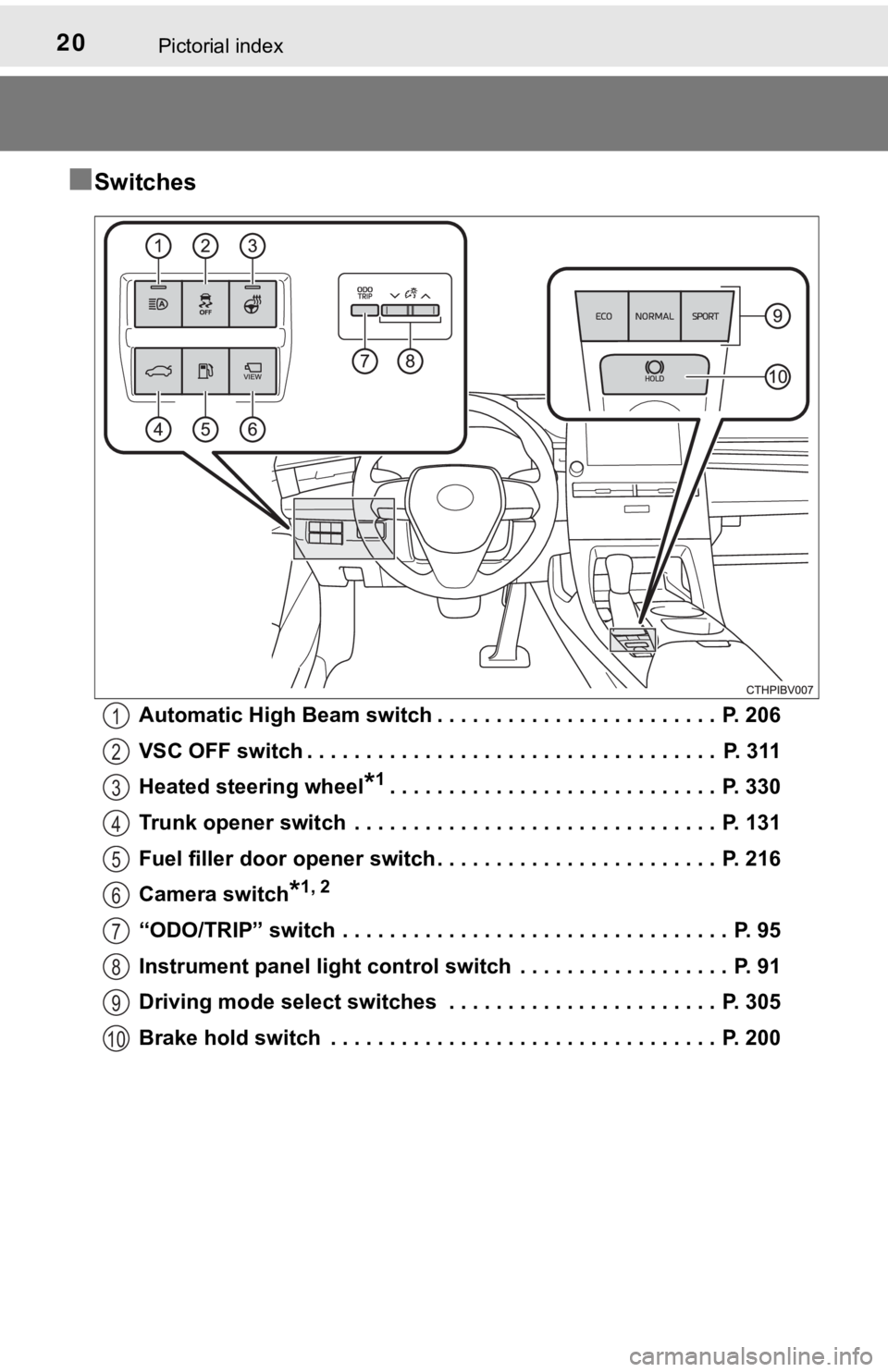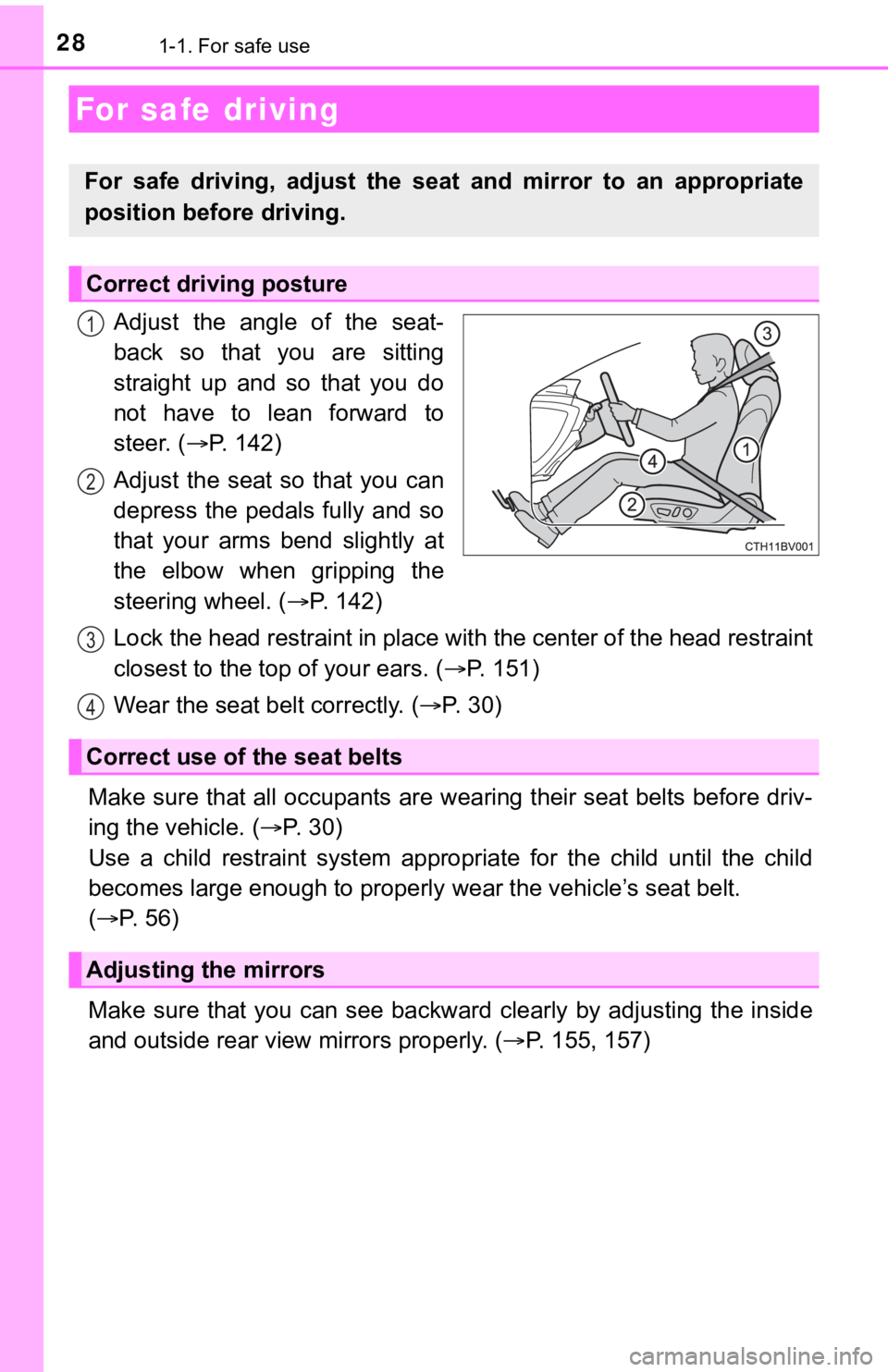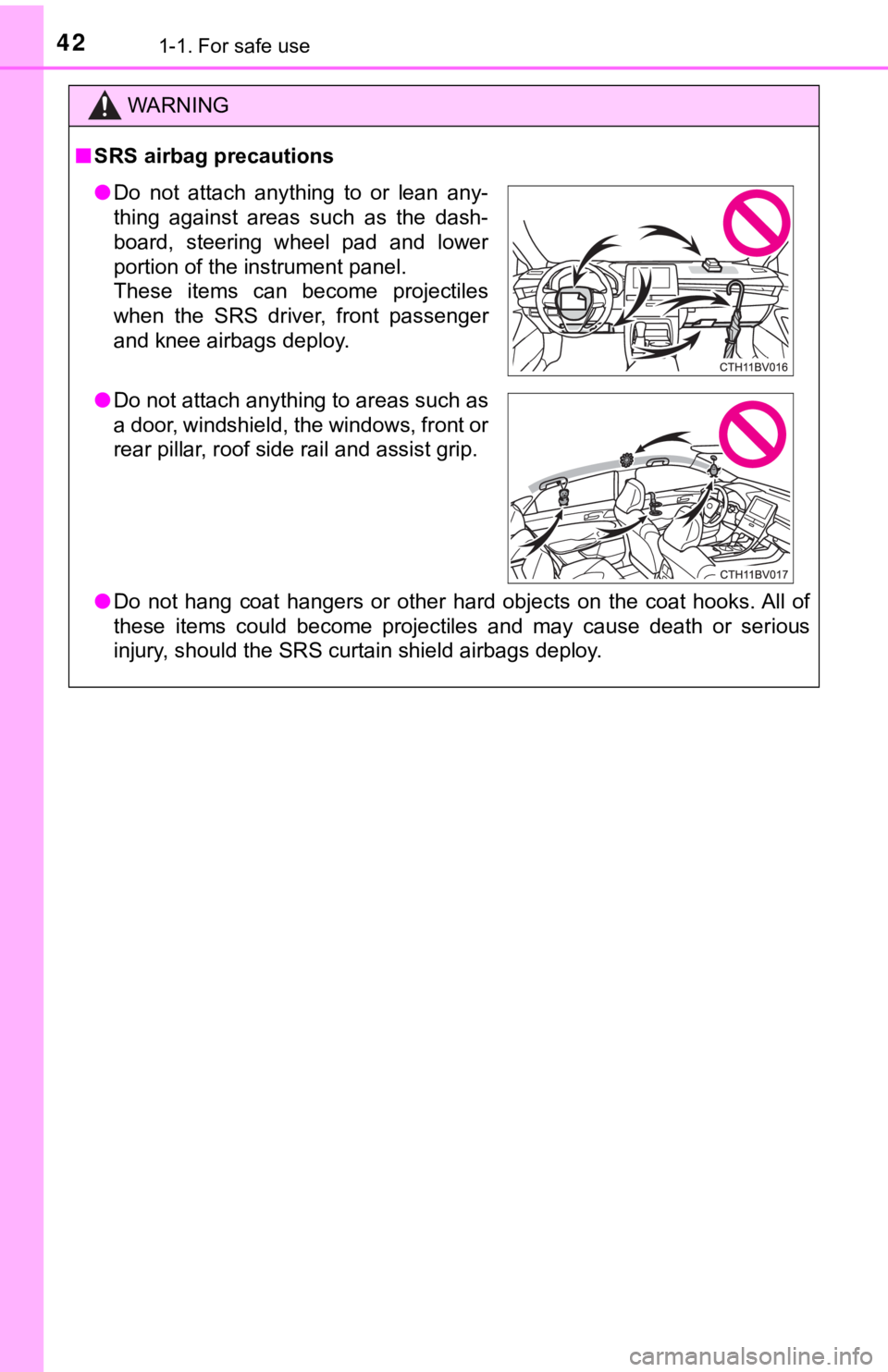wheel TOYOTA AVALON 2021 Owners Manual (in English)
[x] Cancel search | Manufacturer: TOYOTA, Model Year: 2021, Model line: AVALON, Model: TOYOTA AVALON 2021Pages: 548, PDF Size: 13.4 MB
Page 3 of 548

3
1
8 7 5 4
3
2
9
6
3-1. Key information
Keys .................................. 122
3-2. Opening, closing and
locking the doors
Doors................................. 125
Trunk ................................. 131
Smart key system.............. 135
3-3. Adjusting the seats
Front seats ........................ 142
Rear seats ......................... 144
Driving position
memory ........................... 146
Head restraints .................. 151
3-4. Adjusting the steering
wheel and mirrors
Steering wheel .................. 153
Inside rear view mirror....... 155
Outside rear view
mirrors ............................. 157
3-5. Opening and closing
the windows
Power windows ................. 160
Moon roof .......................... 1644-1. Before driving
Driving the vehicle ............. 170
Cargo and luggage ............ 178
Vehicle load limits .............. 181
Trailer towing ..................... 182
Dinghy towing .................... 183
4-2. Driving procedures
Engine (ignition) switch...... 184
Automatic transmission ..... 189
Turn signal lever ................ 195
Parking brake .................... 196
Brake Hold ......................... 200
4-3. Operating the lights
and wipers
Headlight switch ................ 202
Automatic High Beam ........ 206
Windshield wipers
and washer ...................... 210
4-4. Refueling
Opening the fuel tank
cap................................... 214
3Operation of each
component4Driving
Page 4 of 548

TABLE OF CONTENTS4
4-5. Using the driving
support systems
Toyota Safety Sense P ..... 218
PCS
(Pre-Collision System) .... 226
LDA (Lane Departure Alert
with steering control) ....... 237
Dynamic radar cruise
controlwith full-speed
range ............................... 247
BSM
(Blind Spot Monitor) ........ 260
• BSM function ................ 264
• RCTA function .............. 267
Rear Camera Detection
function (vehicles with
panoramic view
monitor) ........................... 272
Intuitive parking assist ....... 276
Intelligent Clearance
Sonar (ICS) ..................... 284
Driving mode select
switches .......................... 305
Driving assist systems....... 309
4-6. Driving tips
Winter driving tips.............. 3175-1. Using the
air conditioning
system and defogger
Automatic air conditioning
system ............................. 322
Heated steering wheel/
seat heaters/seat
ventilators ........................ 329
5-2. Using the interior lights
Interior lights list................. 332
• Interior light ................... 333
• Personal lights............... 333
• Ambient lights................ 334
5-3. Using the storage
features
List of storage features ...... 335
• Glove box ...................... 336
• Console box .................. 336
• Bottle holders ................ 337
• Cup holders ................... 338
• Auxiliary boxes .............. 339
• Open tray ...................... 340
Trunk features ................... 341
5-4. Other interior features
Other interior features........ 342
• Sun visors ..................... 342
• Vanity mirrors ................ 342
• Power outlet .................. 343
• USB charging ports ....... 344
• Wireless charger ........... 346
• Armrest.......................... 355
• Assist grips .................... 355
• Coat hooks .................... 356
Garage door opener .......... 3575Interior features
Page 5 of 548

5
1
8 7 5 4
3
2
9
6
6-1. Maintenance and care
Cleaning and protecting
the vehicle exterior .......... 366
Cleaning and protecting
the vehicle interior ........... 369
6-2. Maintenance
Maintenance
requirements ................... 372
General maintenance ........ 374
Emission inspection and
maintenance (I/M)
programs ......................... 378
6-3. Do-it-yourself
maintenance
Do-it-yourself service
precautions ..................... 379
Hood.................................. 381
Positioning a floor jack ...... 382
Engine compartment ......... 383
Tires .................................. 394
Tire inflation pressure........ 408
Wheels .............................. 411
Air conditioning filter .......... 413
Electronic key battery ........ 415
Checking and replacing
fuses ............................... 418
Light bulbs ......................... 4217-1. Essential information
Emergency flashers ........... 424
If your vehicle has to be
stopped in an
emergency....................... 425
If the vehicle is trapped
in rising water .................. 426
7-2. Steps to take in
an emergency
If your vehicle needs to
be towed .......................... 427
If you think something
is wrong ........................... 432
Fuel pump shut off
system ............................. 433
If a warning light turns on
or a warning buzzer
sounds ............................. 434
If a warning message is
displayed ......................... 444
If you have a flat tire .......... 449
If the engine will
not start ........................... 461
If the electronic key does
not operate properly ........ 463
If the vehicle battery is
discharged ....................... 466
If your vehicle overheats.... 471
If the vehicle becomes
stuck ................................ 474
6Maintenance and care7When trouble arises
Page 20 of 548

20Pictorial index
■Switches
Automatic High Beam switch . . . . . . . . . . . . . . . . . . . . . . . . P. 206
VSC OFF switch . . . . . . . . . . . . . . . . . . . . . . . . . . . . . . . . . . . P. 311
Heated steering wheel
*1. . . . . . . . . . . . . . . . . . . . . . . . . . . . P. 330
Trunk opener switch . . . . . . . . . . . . . . . . . . . . . . . . . . . . . . . P. 131
Fuel filler door opener switch . . . . . . . . . . . . . . . . . . . . . . . . P. 216
Camera switch
*1, 2
“ODO/TRIP” switch . . . . . . . . . . . . . . . . . . . . . . . . . . . . . . . . . P. 95
Instrument panel light control switch . . . . . . . . . . . . . . . . . . P. 91
Driving mode select switches . . . . . . . . . . . . . . . . . . . . . . . P. 305
Brake hold switch . . . . . . . . . . . . . . . . . . . . . . . . . . . . . . . . . P. 200
1
2
3
4
5
6
7
8
9
10
Page 28 of 548

281-1. For safe use
Adjust the angle of the seat-
back so that you are sitting
straight up and so that you do
not have to lean forward to
steer. (P. 1 4 2 )
Adjust the seat so that you can
depress the pedals fully and so
that your arms bend slightly at
the elbow when gripping the
steering wheel. (P. 142)
Lock the head restraint in place with the center of the head restraint
closest to the top of your ears. (P. 1 5 1 )
Wear the seat belt correctly. (P. 3 0 )
Make sure that all occupants are wearing their seat belts before driv-
ing the vehicle. (P. 3 0 )
Use a child restraint system appropriate for the child until the child
becomes large enough to properly wear the vehicle’s seat belt.
(P. 56)
Make sure that you can see backward clearly by adjusting the inside
and outside rear view mirrors properly. (P. 155, 157)
For safe driving
For safe driving, adjust the seat and mirror to an appropriate
position before driving.
Correct driving posture
1
2
Correct use of the seat belts
Adjusting the mirrors
3
4
Page 39 of 548

391-1. For safe use
1
For safety and security
WARNING
■SRS airbag precautions
Observe the following precautions regarding the SRS airbags.
Failure to do so may cause death or serious injury.
●The driver and all passengers in the vehicle must wear their seat belts
properly.
The SRS airbags are supplemental devices to be used with the seat belts.
●The SRS driver airbag deploys with considerable force, and can cause
death or serious injury especially if the driver is very close to the airbag.
The National Highway Traffic Safety Administration (NHTSA) advises:
Since the risk zone for the driver’s airbag is the first 2 - 3 in. (50 - 75 mm)
of inflation, placing yourself 10 in. (250 mm) from your driver airbag pro-
vides you with a clear margin of safety. This distance is measured from
the center of the steering wheel to your breastbone. If you sit less than 10
in. (250 mm) away now, you can change your driving position in several
ways:
• Move your seat to the rear as far as you can while still reaching the ped-
als comfortably.
• Slightly recline the back of the seat.
Although vehicle designs vary, many drivers can achieve the 10 in. (250
mm) distance, even with the driver seat all the way forward, simply by
reclining the back of the seat somewhat. If reclining the back of your
seat makes it hard to see the road, raise yourself by using a firm, non-
<0056004f004c0053005300480055005c0003004600580056004b004c00520051000f000300520055000300550044004c0056004800030057004b0048000300560048004400570003004c00490003005c005200580055000300590048004b004c0046004f00
480003004b0044005600030057004b00440057000300490048[ature.
• If your steering wheel is adjustable, tilt it downward. This points the air-
bag toward your chest instead of your head and neck.
The seat should be adjusted as recommended by NHTSA above, while
still maintaining control of the foot pedals, steering wheel, and your view
of the instrument panel controls.
Page 42 of 548

421-1. For safe use
WARNING
■SRS airbag precautions
●Do not hang coat hangers or other hard objects on the coat hooks. All of
these items could become projectiles and may cause death or serious
injury, should the SRS curtain shield airbags deploy.
●Do not attach anything to or lean any-
thing against areas such as the dash-
board, steering wheel pad and lower
portion of the instrument panel.
These items can become projectiles
when the SRS driver, front passenger
and knee airbags deploy.
●Do not attach anything to areas such as
a door, windshield, the windows, front or
rear pillar, roof side rail and assist grip.
Page 43 of 548

431-1. For safe use
1
For safety and security
WARNING
■SRS airbag precautions
●If a vinyl cover is put on the area where the SRS knee airbag will deploy,
be sure to remove it.
●Do not use seat accessories which cover the parts where the SRS side
airbags inflate as they may interfere with inflation of the SRS airbags.
Such accessories may prevent the side airbags from activating correctly,
disable the system or cause the side airbags to inflate accidentally, result-
ing in death or serious injury.
●Do not strike or apply significant levels of force to the area of the SRS air-
bag components or the front doors.
Doing so can cause the SRS airbags to malfunction.
●Do not touch any of the component parts immediately after the SRS air-
bags have deployed (inflated) as they may be hot.
●If breathing becomes difficult after the SRS airbags have deployed, open a
door or window to allow fresh air in, or leave the vehicle if it is safe to do
so. Wash off any residue as soon as possible to prevent skin irritation.
●If the areas where the SRS airbags are stored, such as the steering wheel
pad and front and rear pillar garnishes, are damaged or cracked, have
them replaced by your Toyota dealer.
●Do not place anything, such as a cushion, on the front passenger's seat.
Doing so will disperse the passenger's weight, which prevents the sensor
from detecting the passenger's weight properly. As a result, the SRS front
<0044004c005500450044004a0056000300490052005500030057004b00480003004900550052005100570003005300440056005600480051004a00480055000300500044005c00030051005200570003004700480053004f0052005c0003004c0051000300
57004b00480003004800590048005100570003005200490003[a collision.
Page 44 of 548

441-1. For safe use
WARNING
■Modification and disposal of SRS airbag system components
Do not dispose of your vehicle or perform any of the following modifications
without consulting your Toyota dealer. The SRS airbags may malfunction or
deploy (inflate) accidentally, causing death or serious injury.
●<002c0051005600570044004f004f00440057004c00520051000f0003005500480050005200590044004f000f00030047004c0056004400560056004800500045004f005c000300440051004700030055004800530044004c00550003005200490003005700
4b0048000300360035003600030044004c005500450044004a[s
●Repairs, modifications, removal or replacement of the steering wheel,
instrument panel, dashboard, seats or seat upholstery, front, side and rear
pillars, roof side rails, front door panels, front door trims or front door
speakers
●Modifications to the front door panel (such as making a hole in it)
●Repairs or modifications of the front fender, front bumper, or side of the
occupant compartment
●Installation of a grille guard (bull bars, kangaroo bar, etc.), snow plows,
winches, or roof luggage carrier
●Modifications to the vehicle’s suspension system
●Installation of electronic devices such as mobile two-way radios and CD
players
●Modifications to your vehicle for a person with a physical disability
Page 45 of 548

451-1. For safe use
1
For safety and security
■If the SRS airbags deploy (inflate)
●Slight abrasions, burns, bruising etc., may be sustained from SRS airbags,
due to the extremely high speed deployment (inflation) by hot gases.
●A loud noise and white powder will be emitted.
●Parts of the airbag module (steering wheel hub, airbag cover and inflator) as
well as the front seats, parts of the front and rear pillars, and roof side rails,
may be hot for several minutes. The airbag itself may also be hot.
●The windshield may crack.
●The interior lights will turn on automatically. (P. 332)
●The emergency flashers will turn on automatically. (P. 424)
●For Safety Connect subscribers, if any of the following situations occur, the
system is designed to send an emergency call to the response center, noti-
fying them of the vehicle’s location (without needing to push the “SOS” but-
ton) and an agent will attempt to speak with the occupants to ascertain the
level of emergency and assistance required. If the occupants are unable to
communicate, the agent automatically treats the call as an emergency and
<004b0048004f0053005600030057005200030047004c00560053004400570046004b00030057004b0048000300510048004600480056005600440055005c00030048005000480055004a004800510046005c00030056004800550059004c00460048005600
110003000b[P. 71)
• An SRS airbag is deployed.
• A seat belt pretensioner is activated.
• The vehicle is involved in a severe rear-end collision.
■SRS airbag deployment conditions (SRS front airbags)
●The SRS front airbags will deploy in the event of an impact that exceeds the
set threshold level (the level of force corresponding to an approximately 12 -
18 mph [20 - 30 km/h] frontal collision with a fixed wall that does not move or
deform).
However, this threshold velocity will be considerably higher in the following
situations:
• If the vehicle strikes an object, such as a parked vehicle or sign pole,
which can move or deform on impact
• If the vehicle is involved in an underride collision, such as a collision in
which the front of the vehicle “underrides”, or goes under, the bed of a
truck
●Depending on the type of collision, it is possible that only the seat belt pre-
tensioners will activate.
●The SRS front airbags for the front passenger will not activate if there is no
passenger sitting in the front passenger seat. However, the SRS front air-
bags for the front passenger may deploy if luggage is put in the seat, even if
the seat is unoccupied.